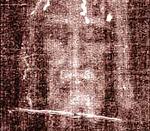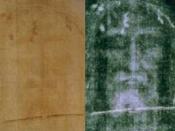The Burial Cloth Shrouded in Controversy
The age of the Shroud of Turin has been widely debated since its official discovery in the 14th century, and is at the base of argument of whether the shroud is authentic. Since its discovery, it has become an icon of Christian Religion, one that provides concrete evidence of the death and resurrection of Christ to those who trust its authenticity. Within the past two decades, falling "squarely within a Catholic tradition, of seeking scientific support for religious revelation", the Catholic Church has exposed the shroud to scientific analysis to attempt to provide a modern-day positive date of origin (Chippindale 6). The results from even these tests have not been wholly accepted to accurately date the shroud's origin. Like Faith in Christian Religion, the age (and underlying authenticity) of the Shroud of Turin may still lie in the beliefs of the individual.
The Shroud of Turin is the alleged burial cloth of Christ, believed so because it contains a full-body negative image of someone that would have been crucified in a similar manner. The shroud first came to the public eye when its existence was announced by its believed first owner, Geoffry I de Charny in 1353 (Gove 91). No actual reports exist about the shroud before this time, although numerous references exist that refer "to a cloth 'miraculously' imprinted with Jesus's face...at least as early as the sixth century AD, with hints and traditions stretching it back still earlier" (History Today 3). As Charny's account of the shroud is the first that fully identifies the shroud as we know it today, its authenticity has become a subjective matter. The two sides of subjectivity believe that the shroud is either authentic or is a medieval artist's rendering. To help prove the validity...


